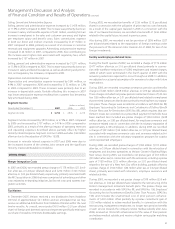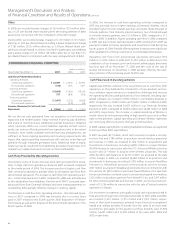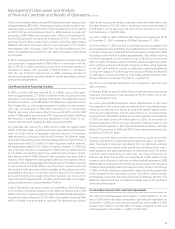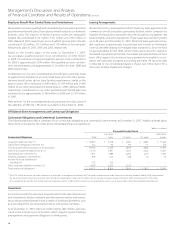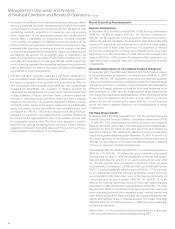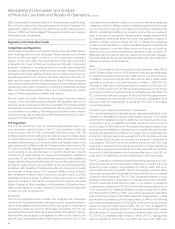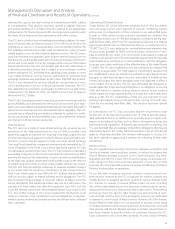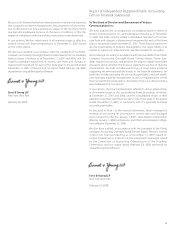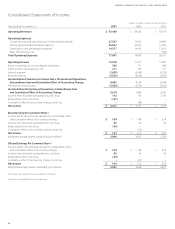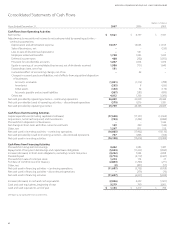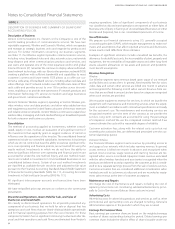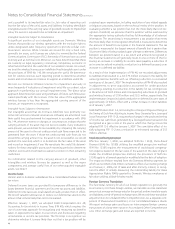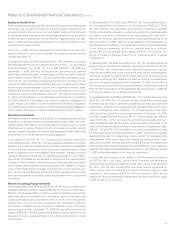Verizon Wireless 2007 Annual Report Download - page 39
Download and view the complete annual report
Please find page 39 of the 2007 Verizon Wireless annual report below. You can navigate through the pages in the report by either clicking on the pages listed below, or by using the keyword search tool below to find specific information within the annual report.
CAUTIONARY STATEMENT CONCERNING
FORWARDLOOKING STATEMENTS
InthisAnnualReportonForm10-Kwehavemadeforward-lookingstate-
ments. These statements are based on our estimates and assumptions
and are subject to risks and uncertainties. Forward-looking statements
include the information concerning our possible or assumed future
results of operations. Forward-looking statements also include those pre-
cededorfollowedbythewords“anticipates,”“believes,”“estimates,”“hopes”
or similar expressions. For those statements, we claim the protection of
the safe harbor for forward-looking statements contained in the Private
SecuritiesLitigationReformActof1995.
The following important factors, along with those discussed elsewhere
inthisAnnualReport,couldaffectfutureresultsandcouldcausethose
results to differ materially from those expressed in the forward-looking
statements:
• materially adverse changes in economic and industry conditions and
labor matters, including workforce levels and labor negotiations, and
any resulting financial and/or operational impact, in the markets served
by us or by companies in which we have substantial investments;
• material changes in available technology, including disruption of our
suppliers’ provisioning of critical products or services;
• the impact on our operations of natural or man-made disasters and
any resulting financial impact not covered by insurance;
• technology substitution;
• an adverse change in the ratings afforded our debt securities by
nationally accredited ratings organizations;
• the final results of federal and state regulatory proceedings concerning
our provision of retail and wholesale services and judicial review of
those results;
• the effects of competition in our markets;
• the timing, scope and financial impact of our deployment of fiber-to-
the-premises broadband technology;
• the ability of Verizon Wireless to continue to obtain sufficient spectrum
resources;
• changes in our accounting assumptions that regulatory agencies,
including the SEC, may require or that result from changes in the
accounting rules or their application, which could result in an impact
on earnings;
• the ability to complete acquisitions and dispositions; and
• the extent and timing of our ability to obtain revenue enhancements
and cost savings following our business combination with MCI, Inc.
37
Wireless Services
The rapid growth of the wireless industry has led to an increase in efforts
by some state legislatures and state public utility commissions to regu-
late the industry in ways that may impose additional costs on Verizon
Wireless. The Communications Act generally preempts regulation by
state and local governments of the entry of, or the rates charged by, wire-
less carriers. Although a state may petition the FCC to allow it to impose
rate regulation, no state has done so. In addition, the Communications
Act does not prohibit the states from regulating the other “terms and
conditions”ofwirelessservice.Whilenumerousstatecommissionsdo
not currently have jurisdiction over wireless services, state legislatures
may decide to grant them such jurisdiction, and those commissions that
already have authority to impose regulations on wireless carriers may
adopt new rules.
State efforts to regulate wireless services have included proposals to
regulate customer billing, termination of service, trial periods for service,
advertising, network outages, the use of handsets while driving, and the
provision of emergency or alert services. Over the past several years, only
a few states have imposed regulation in one or more of these areas, and
in 2006 a federal appellate court struck down one such state statute,
but Verizon Wireless expects these efforts to continue. Some states also
impose their own universal service support regimes on wireless and other
telecommunications carriers, and other states are considering whether to
create such regimes.
Verizon Wireless (as well as AT&T (formerly Cingular) and Sprint-Nextel)
isapartytoanAssuranceofVoluntaryCompliance(“AVC”)with33State
Attorneys General. The AVC, which generally reflected Verizon Wireless’s
practices at the time it was entered into in July 2004, obligates the com-
pany to disclose certain rates and terms during a sales transaction, to
provide maps depicting coverage, and to comply with various require-
ments regarding advertising, billing, and other practices.
At the state and local level, wireless facilities are subject to zoning and
land use regulation. Under the Communications Act, neither state nor
local governments may categorically prohibit the construction of wireless
facilities in any community or take actions, such as indefinite moratoria,
which have the effect of prohibiting service. Nonetheless, securing state
and local government approvals for new tower sites has been and is
likely to continue to be a difficult, lengthy and expensive process. Finally,
state and local governments continue to impose new or higher fees and
taxes on wireless carriers.
Management’s Discussion and Analysis
ofFinancialConditionandResultsofOperations continued


